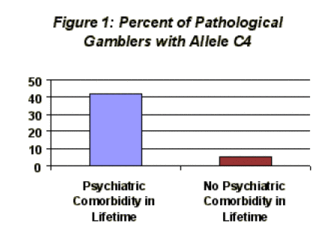Evidence for the existence of a genetic contribution to pathological gambling is mounting. In 1998 The WAGER reported on a study that showed a relationship between pathological gambling and dopamine-related genetic configurations. Similarly, in 1999 The WAGER reported on a study that suggested that pathological gamblers have significantly more heterogeneous dopamine receptor genotypes than non-pathological individuals. The current WAGER summarizes a report by Angela Ibanez and colleagues (Ibanez et al., 2001) that pathological gamblers with certain allele distributions of the Dopamine Receptor D2 (DRD2) might be at higher risk for psychiatric comorbidity.
Ibanez et al. recruited 69 (47 men and 22 women) consecutive treatment seekers at the Hospital Ramon y Cajal in Madrid, Spain. Participants completed several psychological assessments including: (1) the South Oaks Gambling Screen (SOGS), (2) the Structured Clinical Interview for the DSM-III-R, (3) the Global Clinical Impression, (4) the Beck Depression Inventory, (5) the State-Trait Anxiety Inventory, and (6) Zuckerman’s Sensation Seeking Scale. Ibanez et al. also analyzed the participants’ allele distributions.
All participants satisfied DSM criteria for pathological gambling. Approximately 72% (n=50) of the participants had some type of psychiatric comorbidity in their lifetime (current diagnoses n=42). The severity of gambling pathology, as measured by the SOGS, increased linearly with the number of psychiatric comorbid diagnoses (r=0.40, p<0.001). The authors reported that the allele distributions of DRD2 were different for individuals with and without psychiatric comorbidity (Ç2 (1) =13.9 p<0.01) and that, specifically, the presence of the DRD2 allele C4 differed by psychiatric comorbidity (Ç2 (1) =7.0 p<0.01; Figure 1). Interestingly, multiple linear regressions indicated that although the presence of psychiatric comorbidity was predictive of SOGS scores, neither the presence of the allele C4 nor the interaction of the two predictors predicted SOGS scores.
These results suggest that genetic variations and psychiatric comorbidity co-vary in pathological gamblers. While this is important and useful information, there are a few limitations to this study. First, this study has a relatively small sample size from Spain that is comprised mostly of men. Second, although the authors are careful to avoid drawing this conclusion, many may be tempted to interpret these findings as supporting a causal relationship between genetic variations and psychiatric comorbidity. Studies of this nature cannot determine causality. Longitudinal studies with larger samples and more representative populations are warranted. Nevertheless, Ibanez et al. make an important contribution to the literature by identifying yet another genetic piece of the pathological gambling puzzle.
References
Ibanez, A., Blanco, C., Donahue, E., Lesieur, H. R., de Castro, I. P., Fernandez-Piqueras, J., & Saiz-Ruiz, J. (2001). Psychiatric comorbidity in pathological gamblers seeking treatment. The American Journal of Psychiatry, 158(10), 1733-1735.





